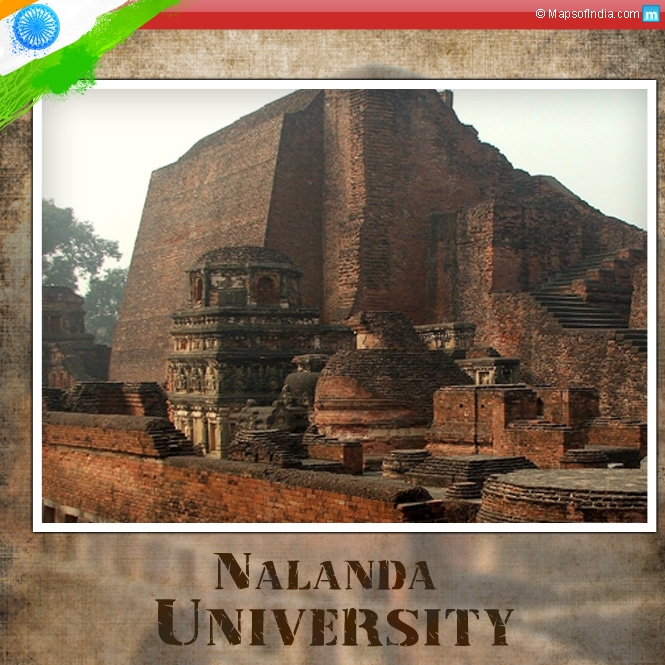Nalanda University, the ancient abode of learning, re-opened its doors on September 1, 2014 with an aim to restore it back to its past glory. This is indeed a very good attempt on the part of the Bihar State Government and Central Government to bring back India’s original international knowledge destination back on its track, after 800 years. With 10 faculty members and 15 students including 5 women, the first academic session began on 1st September 2014 for the programmes: Historical Sciences and Environment and Ecology. Though there were more than 1000 applications from 40 universities all around the world, only 15 students were the lucky ones to get selected, according to the Gopa Sabhrawal, vice-chancellor of Nalanda University. Out of the 15 students, 5 are women. One each is from Japan and Bhutan. All others are Indians.
A 3-day student orientation programme took place in the makeshift university campus at Rajgir, the ancient Buddhist pilgrim town, 100 km away from the capital city Patna. The actual Nalanda University, with a revived and a new look, will be set up at Rajgir, 12 km away from where the original Nalanda University stood. At present, the 15 selected students are staying in a hotel owned by Bihar State Tourism Development Corporation (BSTDC) and classes are held in the convention hall of the state government.
The formal inauguration of the university will be in mid-September and by 2020 the entire university will be completed. The plan is to include 7 schools offering studies on various fields for post-graduate and doctoral students. The selection process is going on and more students will be enrolled by the end of this month.
Ancient history of Nalanda University
Originally established by the Gupta kings in the 5th century AD, Nalanda was one of the oldest learning institutions of not only India but also of the world. Nalanda existed long before the Harvard and Cambridge. From the fifth to the twelfth century AD, Nalanda was the indisputable seat of learning with a long and illustrious position and had over 2,000 teachers and 10,000 students. Students and scholars from distant places like as China, Tibet, Mongolia, Turkey, Korea, Japan, Sri Lanka and South East Asia had come to this university for learning and teaching. The learning, ambience, architecture of this university were mentioned in ancient historical scriptures and books. Detailed accounts were given by the Chinese scholars.
The university not only embraced philosophy and Buddhist studies but also other studies like as literature and mathematics, which attracted many intellectuals from around the world. Nalanda architectural ruins and other components studied by historians revealed how the university adopted holistic nature of learning and attracted all knowledge lovers. However, this ancient abode of learning was destroyed by the Turkish invaders in the 12th century. Gradually, more new universities came up in the West like Al Azhar in Cairo, Bologna in Italy, and Oxford in the United Kingdom (1167 CE ). The centre of excellence lots its ancient glory and charm and got faded away in the ruins and from the minds of the people.
Restructuring Nalanda University
- The first idea of reviving the university was made by Former President of India Dr APJ Abdul Kalam in 2006, while addressing the Bihar State Legislative Assembly.
- The Nalanda University Act was passed by the Parliament in September 2010, encouraging its creation.
- An international “mentoring panel” was formed with many foreign dignitaries and economist Amartya Sen as the Chairman of the governing body of the university.
- The reviving of this ancient old university gained momentum by Manmohan Singh, the former UPA prime minister in East Asia Summit (EAS) in 2013, where he got foreign support for its restructuring.
- Seven EAS countries like Cambodia, Singapore, Australia, Brunei, New Zealand, Laos and Myanmar had pledged to contribute to the project. China had committed $1 million, Australia about A$ 1million, Singapore $5-6 million, Thailand $ 1,00,000 for its reconstruction, sources said.
- The Nalanda board had approved the architectural plan of the university in May 2013.
- The university will be set up on a huge 443-acre campus built near the original ruins. The highlighting architectural feature will be a huge lake at the centre of the campus with a dome-shaped structure half emerged in the lake, which will act as the library.
- The central government had sanctioned Rs. 2,700 crores for a period of 10 years.
Courses offered
The University will be restructured with an aim to attract international students and faculty who will bring global excellence into India and also spread India’s knowledge and culture to the outside world. The university will offer seven schools of learning for Master’s, M Phil and Ph D degrees:
- Historical Studies
- Buddhist Studies, Philosophy and Comparative Religions
- Linguistics and Literature
- Ecology and Environment Studies
- International Relations and Peace Studies
- Information Science and Technology
- Economics and Management.
Will it be able to bring back its past glory?
Nalanda, even now, is a name known across the world as an ancient university which attracted students and scholars from far away. The new university also strives to have a global character. The new university will strive to match the same standards of the original university. Talking about the courses, Amartya Sen said that the main objective of courses like Buddhist philosophy and religious studies is to connect the modern university to its historic past. Foreign Minister of Singapore George Yeo said that the main idea was to set up a university that facilitates exchange of ideas, where each and everyone contribute to the development of others. Gopa Sabharwal, vice-chancellor said at the opening of the university on September 1st ,that the university will get a modern avatar but the original ethos will remain the same. Whether this university will be able to get back the same stature as yesteryears or not, only time will tell. Till then, let us keep our fingers crossed and pray that it will be the best known learning centre all across the world, making our country proud…





